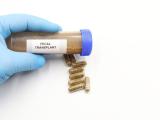Mar 6, 2013
Report: Faster food outbreak response needed
America needs better ways to quickly detect and respond to foodborne disease outbreaks, and it needs to bolster public health departments that conduct outbreak investigations, the University of Pittsburgh Medical Center's (UPMC's) Center for Biosecurity said in a report it released yesterday. The authors analyzed studies on foodborne outbreak response and interviewed dozens of federal and state officials and other experts. The report said that determining the source of outbreaks remains a top priority but will only get harder as the food supply chain becomes more complex. It also said that national surveillance systems have been crucial in detecting outbreaks, among other findings. The report's authors said the country needs to improve the speed and accuracy of outbreak detection and response. "The sooner the source of an outbreak is identified, the sooner we can issue accurate targeted warnings and take the contaminated products off the shelves," said lead author Jennifer Nuzzo in a UPMC news release. Recommendations include funding cutting-edge technology, restoring state health department funding, tapping the private sector more effectively, providing adequate funds for the 2011 Food Safety Modernization Act, and improving integration of existing surveillance networks.
Mar 5 executive summary of report
Mar 5 full report
Mar 5 UPMC news release
Campylobacter outbreak linked to raw milk in Alaska grows to 24 cases
Alaska health officials are reporting 6 more illnesses in a Campylobacter outbreak linked to raw milk, raising the total so far to 24, according to a Mar 4 report from KTVA, a CBS TB affiliate in Anchorage. One of the cases is a secondary infection in an infant who was exposed to a sick adult. In earlier statements the Alaska health department's Section of Epidemiology linked the infections to raw milk from a Kenai Peninsula farm that operates a cow-share program. The milk was distributed through the Kenai Peninsula and in Anchorage and Sitka.
Feb 26 CIDRAP News Scan "Alaska Campylobacter outbreak tied to raw milk expands to 18 cases"
Genotype, biomarkers predict severity of C difficile infections
Genotype and severity biomarkers in Clostridium difficile infections (CDIs) are predictive of outcome, with clades 5, 2, and 1 resulting in the highest short-term mortality rates, says a study published in Clinical Infectious Diseases yesterday. The authors examined a database of consecutive C difficile toxin enzyme immunoassay (EIA)–positive fecal samples collected in Oxfordshire, United Kingdom (population about 600,000), over nearly 5 years to determine whether certain genotypes as determined by multilocus sequence typing (MLST) were associated with increased mortality and with strain-specific effects on severity biomarkers. Mortality at 14 days as well as baseline levels of 15 biomarkers were compared between patients with CDIs of different clades and CDI-negative controls. Mortality was 13% in 2,222 adults (median age 78) with 2,745 EIA-positive samples and in 5% of 20,722 adults (median age 74) with 27,550 EIA-negative samples, for an absolute attributable mortality of 7.7% (95% confidence interval [CI], 6.4% to 9.0%). The clade 5 strain (PCR-ribotype-078/ST-11) showed the highest rate of mortality (16 of 63 [25%], followed by clade 2 (111 of 560 [20%]), and clade 1 (137 of 1,168 [12%].
Mar 5 Clin Infect Dis study




















